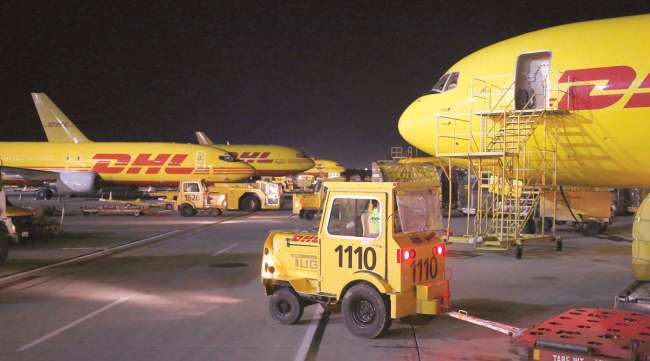After Mixed Financial Results in 2019, 3PLs Face Coronavirus Headwinds

[Stay on top of transportation news: Get TTNews in your inbox.]
Coming off an extraordinary growth market in 2018, third-party logistics companies operating in the United States experienced a more mixed year in 2019.
After companies imported products and grew inventories in 2018 to beat the implementation of the Trump administration’s import tariffs during a good domestic economic environment, 2019 saw a year-over-year decline in transportation activity as the tariffs took hold.
While many 3PLs are still providing us with 2019 financials, Armstrong & Associates’ current estimates show total U.S. 3PL net revenue — gross revenue less purchased transportation — grew 5.7% to $91.3 billion in 2019, while overall gross revenue declined 0.9%, bringing the total U.S. 3PL market to $211.5 billion. Last year marked the first year-over-year 3PL market contraction since its 16% decline in 2009 during the Great Recession. However, the slight market decline in 2019 should be viewed in light of 2018’s extraordinary 15.8% growth, the most since 2010 when the market bounced back from the recession.
For 2020, Armstrong & Associates is expecting negative impacts to the U.S. 3PL market as the COVID-19 virus disrupts domestic operations and negatively impacts global and domestic supply chains. We expect to see a significant “bullwhip” effect as some smaller suppliers close shop, and manufacturers and retailers draw down inventories starting later in March. As in Asia, once the virus has spread, there will be significant operational disruptions and a general slowdown in activity. Once economic activity picks up, most likely in the third quarter, there will be significant order volume to replenish inventories and fill back orders, driving demand for airfreight and expedited transportation.

Armstrong
While it is extremely hard to model the impact of the coronavirus at this time, we are estimating an 8-10% decline in 3PL gross revenues in the second quarter of 2020 and 4-8% gross revenue increases in the third and fourth quarters as normal operations resume. The overall market in 2020 should be between a 2% decline and 3% growth.
Within the asset-heavy dedicated contract carriage (DCC) 3PL segment, 2018’s tight domestic motor carrier market led to 15.8% net revenue growth. This growth continued into 2019, driving 12.1% net revenue growth for a total of $19.9 billion in the DCC segment. DCC’s overall segment growth came even as many domestic truckload carriers, including large truckload carrier Celadon, sought bankruptcy protection. Most DCC contracts have one- to three-year terms with dedicated asset requirements. This makes them much “stickier” than standard shipper-carrier trucking contracts, and they were a strong contributor to the segment’s continued strong performance in 2019. Armstrong & Associates’ market research shows dry van trailers being used for 70% of DCC truckloads, reefers for 16%, flatbeds for 6%, and tankers and others for 8%.
The DCC segment leader, J.B. Hunt Dedicated Contract Services with 11,087 power units in dedicated, posted above average net revenue growth of 24.6% to $2.7 billion, pushing its DCC market share to 13.5% on a net revenue basis. Penske Logistics, helped by its 2018 acquisition of Epes Transport System, has grown into the third-largest dedicated fleet with 5,530 power units.
We expect more moderate DCC demand and growth in 2020. A lot will depend on underlying contract truckload rates finding support in the market later in the year and disruptions from the coronavirus on shipper and DCC operations.
The value-added warehousing and distribution (VAWD) 3PL segment had gross revenue growth of 9% to $47.2 billion in 2019. It was the best growth the segment has realized since 2010, when VAWD posted a 12.9% increase. VAWD net revenues grew 9.2% to $36.1 billion. The average contract warehousing agreement has a three-year term and while there is significant market-driven pricing pressure, it allows for pricing stability over the life of the contract.
VAWD 3PLs continue to benefit from growth in retail e-commerce business, which continues to be the fastest-growing domestic 3PL segment with a compound annual growth rate of 18%. Many VAWD 3PLs are supporting retail brands’ strategies to manage their own order fulfillment channels and avoid being captive to large e-retailer platforms such as Amazon and Alibaba. Operationally, the growth in e-commerce business has meant an expansion in multiclient warehousing and fulfillment operations.
VAWD also benefited from the pending December 2019 import tariff increase that generated uncertainty from 3PL customers and led to continued inventory builds. As the coronavirus continues to disrupt supply chains, domestic inventories will be drawn down. While the virus works its way through domestic supply chains, we anticipate slower economic and warehousing activity. As economic activity improves, most likely in the third quarter, there will be a rush to replenish inventory and fill back orders.
Beyond the current coronavirus disruption, an ongoing headwind for VAWD 3PLs has been the “Amazon effect.” 3PLs are continuing to see increased competition from Amazon for labor and warehouse space. This has dramatically impacted warehouse employee wages and lease rates in key distribution areas such as Plainfield, Ind., and California’s Inland Empire. In turn, it is driving significant interest from VAWD 3PLs to automate warehouses with autonomous robotic solutions to support activities such as picking, put-away and cycle counting. This has benefited suppliers such as Fetch Robotics, Locus Robotics and PINC Solutions.
In 2019, slack demand, abundant carrier capacity and corresponding lower truckload rates drove the nonasset-based domestic transportation management (DTM) 3PL segment’s gross revenue down 5.5% to $81.7 billion, while net revenue decreased 1.7% to $13.2 billion. Eighty-three percent of DTM’s total segment revenues come from freight brokerage, which primarily relies on one-year agreements with virtually no volume commitments like those in DCC. Last year was the DTM segment’s only decline since the 2009 recession, when gross revenue fell 15% and net revenue was down 11.4%. It was a stark contrast to 2018, when extraordinary domestic carrier demand during the inventory buildup prior to the implementation of import tariffs led DTM to a whopping 20.6% gross revenue increase.

In March, truckload rates were starting to stabilize, but the second and third quarters will be challenging as the coronavirus spreads and disrupts domestic and global supply chains, decreasing domestic transportation demand. As operations come back to full strength, most likely in the third quarter, we anticipate a need for more expedited transportation as shippers look to quickly fill back orders and replenish inventories.
The DTM segment is led by C.H. Robinson. Its North American Surface Transportation division’s net revenues decreased 5.7% from $1.906 billion in 2018 to $1.797 billion in 2019 and accounted for 13.6% of the total DTM segment net revenue. While it is still the segment leader, its market share as measured by net revenue dropped 0.6% year-over-year and is significantly lower than eight years ago, when its market share was more than 20%. Part of C.H. Robinson’s 2020 strategy is to gain back some of the market share it has lost to competitors such as Total Quality Logistics, which generated 2019 net revenue of $687 million (down 0.6% from 2018); Echo Global Logistics with $386 million in net revenue (off 8.2% from 2018); and Mode Transportation, which registered $285 million in net revenue as it combined with SunteckTTS in 2019.
On the DTM “watch list” are rapidly growing Arrive Logistics and Nolan Transportation Group. Arrive had year-over-year net revenue growth of 43.8% to $69 million and 2019 gross revenue of $550 million. CEO Matt Pyatt and President Eric Dunigan came from Command Transportation and founded Arrive in 2014 before Command’s $420 million sale to Echo Global Logistics in June 2015. NTG recorded solid year-over-year net revenue growth of 16.7% to $125 million and grew its 2019 gross revenue to $875 million. Gryphon Investors bought a majority stake in NTG through its portfolio company Transportation Insight in December 2018.
One thing digital freight brokers such as Uber Freight, Convoy and Transfix have done is place an emphasis on “digitalizing” DTM operations. While managed transportation (versus freight brokerage) has been highly automated for years via transportation management software, electronic data interchange and other systems interfaces, most freight brokerage operations still have many manual processes. However, traditional DTMs have not been standing still, and a plethora of technology solutions have come to market over the past three years to augment traditional TMS systems and digitalize freight brokerage operations. These tend to fall into four groups: account management automation, capacity intelligence and load matching, visibility and exception management, and back-office automation.
The international transportation management (ITM) 3PL segment, consisting of air and ocean freight forwarding and complementary value-added services, posted a 5.2% gross revenue decline in 2019, dropping to $58.7 billion, while net revenue declined a slight 0.2% to $22.1 billion. Like its domestic brethren DTM, ITMs tend to contract on an annual basis for air and ocean freight forwarding services.
Airfreight was the weakest subsegment as the 2018 pre-import tariff inventory build passed and shippers converted to lower-cost ocean freight where possible. Ocean freight also was soft in 2019 after the 2018 inventory build. On the plus side, all of the tariff import duties changes keep ITMs’ customs and compliance departments busy and drove increased revenues in those operations.
We anticipate a weak first and second quarter due to extended New Year’s holidays in China and coronavirus-driven supply chain disruptions globally. Once the coronavirus lessens, we should see a peak in airfreight demand, most likely in the late second or early third quarter as shippers scramble to fill back orders and rebuild inventories. The ITM segment also is looking forward to the finalization of the U.S.-China trade deal, which could further reduce or eliminate import tariffs and improve trading conditions between the world’s top economies.

►XPO still No. 1, but for how long?
►How 3PLs are evolving
►Map: Where the Top 50 are
Sector Rankings
Freight Brokerage | Dedicated
Dry Storage Warehousing
Refrigerated Warehousing
Ocean Freight | Airfreight
Expeditors International, the largest of the U.S.-based freight forwarders, had a better than average 2019 with gross revenue increasing 0.5% to $8.2 billion and net revenue increasing 0.6% to $2.6 billion. The company’s Customs Brokerage and Other Services division, which includes DTM and VAWD, was a bright spot in 2019, growing its gross revenue 16% to $3 billion and net revenue 6.4% to $1.2 billion. It is now Expeditors’ fastest- growing business segment and has grown to 47% of Expeditors’ total net revenue. Airfreight dropped to 30% of 2019 net revenue and ocean freight was 23%.
While 2019 was a negative growth year with a gross revenue decline of 6.9% and net revenue decline of 1.9%, C.H. Robinson’s Global Forwarding division has been expanding rapidly in ITM via a mix of acquisitions and organic growth. Its 2019 gross revenue was $2.3 billion and its net revenue was $534 million.
Armstrong & Associates Inc. is a market research and consulting firm based in West Allis, Wis. The company publishes a Who’s Who in Logistics and Supply Chain Management, provides legal and expert witness services and advice on mergers and acquisitions to investors, industry analysts and supply chain participants.
Want more news? Listen to today's daily briefing:

